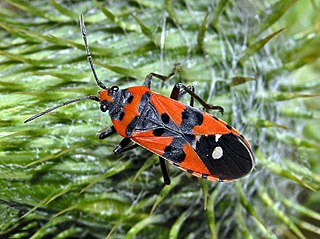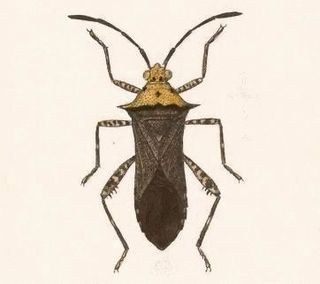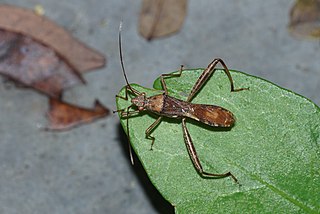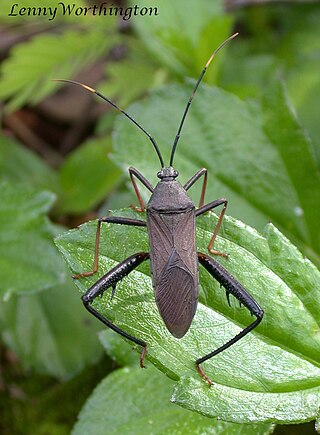
Pentatomidae is a family of insects belonging to the order Hemiptera, generally called shield bugs or stink bugs. Pentatomidae is the largest family in the superfamily Pentatomoidea, and contains around 900 genera and over 4700 species. As hemipterans, the pentatomids have piercing sucking mouthparts, and most are phytophagous, including several species which are severe pests on agricultural crops. However, some species, particularly in the subfamily Asopinae, are predatory and may be considered beneficial.

Pyrrhocoridae is a family of insects with more than 300 species world-wide. Many are red coloured and are known as red bugs and some species are called cotton stainers because their feeding activities leave an indelible yellow-brownish stain on cotton crops. A common species in parts of Europe is the firebug, and its genus name Pyrrhocoris and the family name are derived from the Greek roots for fire "pyrrho-" and bug "coris". Members of this family are often confused with, but can be quickly separated from, Lygaeidae by the lack of ocelli on the top of the head.

Pentatominae is a subfamily of Pentatomidae, a family of shield bugs. This subfamily is the largest one within the Pentatomidae, having 4937 species classified in 938 genera. Species in this subfamily are phytophages and several of them are considered agricultural pests. Some invasive pentatomines such as Halyomorpha halys and Bagrada hilaris have been considered household pests. Higher systematics of the group have been revised by Rider et al.

The Harpactorinae are a large subfamily of the Reduviidae. About 300 genera and 2,000 species worldwide have been described. Some of the species of the genera Zelus, Pselliopus, Sinea, and Apiomerus are of interest as biological pest control agents.

Acanthaspis Amyot & Serville, 1843, is a genus of assassin bugs. Members of the genus are known to disguise themselves by attaching bits of debris to aid in camouflage.

Leptocoris is the largest genus of bugs in the subfamily Serinethinae. Species in this genus are distributed throughout Africa, South Asia, and Oceania and are thought to have originated in Africa, where the greatest diversity of Leptocoris species are found.
Hygia is a large genus of Asian bugs in the tribe Colpurini, erected by Philip Reese Uhler in 1861.

Sycanus is a genus of assassin bug with many species that are found in the African and Asian region.

Chrysocoris is a genus of brightly colored shield-backed bugs belonging to the family Scutelleridae, erected by Carl Wilhelm Hahn in 1834. Species are recorded from South and SE Asia.

Dysdercus is a widespread genus of true bugs in the family Pyrrhocoridae; a number of species attacking cotton bolls may be called "cotton stainers".

Lygaeus is a genus of seed bugs in the family Lygaeidae. There are more than 60 described species in Lygaeus.

Zicca is a genus of leaf-footed bugs in the family Coreidae. There are about 19 described species in Zicca.

Piezogaster is a genus of leaf-footed bugs in the family Coreidae. There are at least 30 described species in Piezogaster.

Oncopeltus is a genus of seed bugs in the family Lygaeidae, which has at least 40 described species.

Riptortus is a genus of broad-headed bugs in the family Alydidae. There are more than 20 described species in Riptortus.

Physopelta is a genus of bordered plant bugs in the family Largidae. There are about 30 described species in Physopelta, found in Asia and Oceania.

Mictis is a genus of sap-sucking insects in the family Coreidae, with species recorded from India, China, Vietnam and Malesia through to Australia. It was described by William Elford Leach in 1814.

Acanthocoris is the type genus of the tribe Acanthocorini, erected by Amyot and Serville in 1843. Species of these leaf-footed bugs have been recorded from Africa and Asia.

The Cloresmini, sometimes called bamboo coreids, are a tribe of leaf-footed bugs, in the subfamily Coreinae erected by Carl Stål in 1873. Genera are distributed from India, China, Indochina, Malesia through to New Guinea.


















